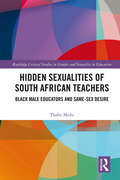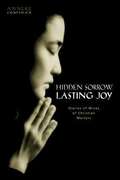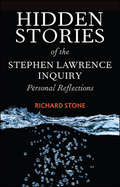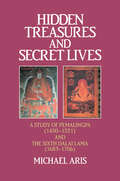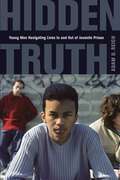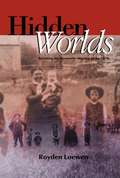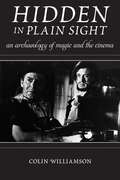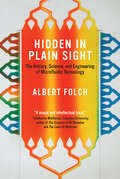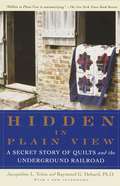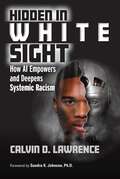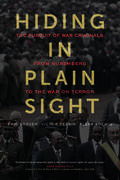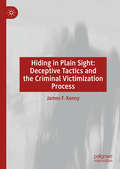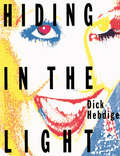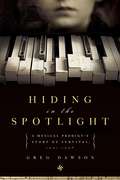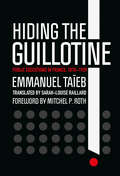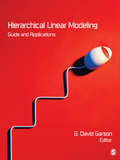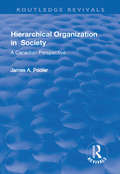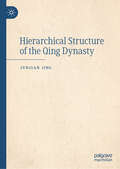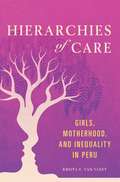- Table View
- List View
Hidden Sexualities of South African Teachers: Black Male Educators and Same-sex Desire (Routledge Critical Studies in Gender and Sexuality in Education)
by Thabo MsibiSouth Africa remains a global leader in the legislative protection of individuals who engage in same-sex relations, and is the only country in Africa where the rights of these individuals are explicitly recognized and protected by the constitution. Yet South Africa’s identities are still contested and evolving, particularly for same-sex desiring teachers – many are forced to locate their sexualities privately for fear of being ostracized, bullied or losing their jobs, resulting in the miseducation of young people in schools. This volume reveals the various ways in which black South African male teachers construct their sexual and professional identities, how they accommodate structural dictates while simultaneously resisting them, and the effect this has on students. Presenting the day-to-day experiences of eight same-sex desiring teachers within repressive contexts, this volume challenges the Western origins and assumptions of queer theory, particularly its inability to confront communal forms of social organizing and its focus on individual agency. It asks for more socially responsive theorizing that takes into account the role played by location, race, class, gender and sexual identification within South African and international contexts.
Hidden Sorrow, Lasting Joy: The Forgotten Women of the Persecuted Church
by Anneke CompanjenStories of women persecuted for their faith around the world. Includes resources for helping.
Hidden Stories of the Stephen Lawrence Inquiry: Personal Reflections
by Richard StoneYoung people who come into contact with police officers on the streets today have little idea of the significance of the stabbing to death of Stephen Lawrence in a racist attack in 1993. Only their parents or grandparents remember the daily exposures of police incompetence and indirect racism which were given high profile in the media for six months. The repercussions of the case are still ongoing with the long overdue conviction in 2012 of two of the original suspects, and in the same year a number of racist assaults by police. This accessible and engaging book includes analysis of hitherto inaccessible transcripts. These dramatically show how the Inquiry was undermined to the point of failure to produce the desired results. Dr Stone also discusses contemporary issues and the relevance of the Inquiry today. This paperback edition is updated with a new Afterword, including revelations about police surveillance on members of the public who attended the Lawrence Inquiry, Dr Stone’s meeting with Mark Ellison QC prior to the release of his report on possible corruption and the role of undercover policing in the Stephen Lawrence case, and proposals for action on implementation of the agenda set by the Lawrence Inquiry. Hard-hitting and full of insightful detail, this book makes essential reading for academics, students, researchers and anyone interested in institutional racism, particularly in the police.
Hidden Treasures & Secret Lives: A Study Of Pemalingpa (1450-1521) And The Sixth Dalai Lama (1683-1706)
by ArisFirst published in 1989. Routledge is an imprint of Taylor & Francis, an informa company.
Hidden Truth: Young Men Navigating Lives In and Out of Juvenile Prison
by Adam ReichHidden Truth takes the reader inside a Rhode Island juvenile prison to explore broader questions of how poor, disenfranchised young men come to terms with masculinity and identity. Adam D. Reich, who worked with inmates to produce a newspaper, writes vividly and memorably about the young men he came to know, and in the process extends theories of masculinity, crime, and social reproduction into a provocative new paradigm. Reich suggests that young men's participation in crime constitutes a game through which they achieve "outsider masculinity." Once in prison these same youths are forced to reconcile their criminal practices with a new game and new "insider masculinity" enforced by guards and administrators.
Hidden Wisdom: Secrets of the Western Esoteric Tradition
by Tim Wallace-Murphy“The best book about the secret tradition I’ve read for many years. Tim Wallace-Murphy writes with style, passion and truth. A magnificent achievement.” —Graham Hancock, New York Times–bestselling author of Fingerprints of the GodsFrom Egyptian mythology to Jewish mysticism, Rome and Greece to the druids and the gnostics, Tim Wallace-Murphy exposes a fascinating lineage of hidden mysteries and secret societies, continuing through the Templars, Rosicrucians, and Freemasons to our modern visionaries. This hidden stream of spirituality and that of sacred knowledge are inseparably entwined to form the single most important continuous strand in the entire Western esoteric tradition.This tradition exerted a seminal influence on the thinking of the builders of the great cathedrals/ leading teachers in ecclesiastical schools/ philosophers/ playwrights/ poets such as Shakespeare, Goethe, Blake, and W. B. Yeats/ and on artists and Renaissance giants such as Leonardo da Vinci and Michelangelo. It is also the root from which sprang alchemy and modern science.Now, as more people are looking to find information on the alternatives to dominant religions and dogmas that have told us what to think and how to behave, as faith has been questioned by religious scandals, economic meltdowns, and an increasingly sick planet Earth, Wallace-Murphy reveals the secrets of the masters, including invaluable spiritual insights into everyday life that have been hidden throughout the ages. He shows us who kept this spiritual tradition alive despite appalling persecution, so that we in the twenty-first century might benefit from its accumulated fruits and ennoble our lives.Hidden Wisdom will be of immense interest to readers of the number-one bestseller The Lost Symbol as it explains much of Dan Brown’s focus on the ancient mysteries.
Hidden Worlds: Revisiting the Mennonite Migrants of the 1870s
by Royden LoewenIn the 1870s, approximately 18,000 Mennonites migrated from the southern steppes of Imperial Russia (present-day Ukraine) to the North American grasslands. They brought with them an array of cultural and institutional features that indicated they were a "transplanted" people. What is less frequently noted, however, is that they created in their everyday lives a world that ensured their cultural longevity and social cohesiveness in a new land.Their adaptation to the New World required new concepts of social boundary and community, new strategies of land ownership and legacy, new associations, and new ways of interacting with markets. In Hidden Worlds, historian Royden Loewen illuminates some of these adaptations, which have been largely overshadowed by an emphasis on institutional history, or whose sources have only recently been revealed. Through an analysis of diaries, wills, newspaper articles, census and tax records, and other literature, an examination of inheritance practices, household dynamics, and gender relations, and a comparison of several Mennonite communities in the United States and Canada, Loewen uncovers the multi-dimensional and highly resourceful character of the 1870s migrants.
Hidden in Plain Sight
by Colin WilliamsonWhat does it mean to describe cinematic effects as "movie magic," to compare filmmakers to magicians, or to say that the cinema is all a "trick"? The heyday of stage illusionism was over a century ago, so why do such performances still serve as a key reference point for understanding filmmaking, especially now that so much of the cinema rests on the use of computers? To answer these questions, Colin Williamson situates film within a long tradition of magical practices that combine art and science, involve deception and discovery, and evoke two forms of wonder--both awe at the illusion displayed and curiosity about how it was performed. He thus considers how, even as they mystify audiences, cinematic illusions also inspire them to learn more about the technologies and techniques behind moving images. Tracing the overlaps between the worlds of magic and filmmaking, Hidden in Plain Sight examines how professional illusionists and their tricks have been represented onscreen, while also considering stage magicians who have stepped behind the camera, from Georges Méliès to Ricky Jay. Williamson offers an insightful, wide-ranging investigation of how the cinema has functioned as a "device of wonder" for more than a century, while also exploring how several key filmmakers, from Orson Welles to Christopher Nolan and Martin Scorsese, employ the rhetoric of magic. Examining pre-cinematic visual culture, animation, nonfiction film, and the digital trickery of today's CGI spectacles, Hidden in Plain Sight provides an eye-opening look at the powerful ways that magic has shaped our modes of perception and our experiences of the cinema.
Hidden in Plain Sight
by David Newhouse Cora J. Voyageur Dan BeavonThe acclaimed and accessible Hidden in Plain Sight series showcases the extraordinary contributions made by Aboriginal peoples to Canadian identity and culture. This collection features new accounts of Aboriginal peoples working hard to improve their lives and those of other Canadians, and serves as a powerful contrast to narratives that emphasize themes of victimhood, displacement, and cultural disruption.In this second volume of the series, leading scholars and other experts pay tribute to the enduring influence of Aboriginal peoples on Canadian economic and community development, environmental initiatives, education, politics, and arts and culture. Interspersed are profiles of many significant Aboriginal figures, including singer-songwriter and educator Buffy Sainte-Marie, politician Elijah Harper, entrepreneur Dave Tuccaro, and musician Robbie Robertson. Hidden in Plain Sight continues to enrich and broaden our understandings of Aboriginal and Canadian history, while providing inspiration for a new generation of leaders and luminaries.
Hidden in Plain Sight: The History, Science, and Engineering of Microfluidic Technology
by Albert FolchStories behind essential microfluidic devices, from the inkjet printer to DNA sequencing chip.Hidden from view, microfluidics underlies a variety of devices that are essential to our lives, from inkjet printers to glucometers for the monitoring of diabetes. Microfluidics—which refers to the technology of miniature fluidic devices and the study of fluids at submillimeter levels—is invisible to most of us because it is hidden beneath ingenious user interfaces. In this book, Albert Folch, a leading researcher in microfluidics, describes the development and use of key microfluidic devices. He explains not only the technology but also the efforts, teams, places, and circumstances that enabled these inventions. Folch reports, for example, that the inkjet printer was one of the first microfluidic devices invented, and traces its roots back to nineteenth-century discoveries in the behavior of fluid jets. He also describes how rapid speed microfluidic DNA sequencers have enabled the sequencing of animal, plant, and microbial species genomes; organs on chips facilitate direct tests of drugs on human tissue, leapfrogging over the usual stage of animal testing; at-home pregnancy tests are based on clever microfluidic principles; microfluidics can be used to detect cancer cells in the early stages of metastasis; and the same technology that shoots droplets of ink on paper in inkjet printers enables 3D printers to dispense layers of polymers. Folch tells the stories behind these devices in an engaging style, accessible to nonspecialists. More than 100 color illustrations show readers amazing images of microfluids under the microscope.
Hidden in Plain View: A Secret Story of Quilts and the Underground Railroad
by Jacqueline L. Tobin Raymond G. DobardThe fascinating story of a friendship, a lost tradition, and an incredible discovery, revealing how enslaved men and women made encoded quilts and then used them to navigate their escape on the Underground Railroad. In Hidden in Plain View, historian Jacqueline Tobin and scholar Raymond Dobard offer the first proof that certain quilt patterns, including a prominent one called the Charleston Code, were, in fact, essential tools for escape along the Underground Railroad. In 1993, historian Jacqueline Tobin met African American quilter Ozella Williams amid piles of beautiful handmade quilts in the Old Market Building of Charleston, South Carolina. With the admonition to "write this down," Williams began to describe how slaves made coded quilts and used them to navigate their escape on the Underground Railroad. But just as quickly as she started, Williams stopped, informing Tobin that she would learn the rest when she was "ready." During the three years it took for Williams's narrative to unfold—and as the friendship and trust between the two women grew—Tobin enlisted Raymond Dobard, Ph.D., an art history professor and well-known African American quilter, to help unravel the mystery.Part adventure and part history, Hidden in Plain View traces the origin of the Charleston Code from Africa to the Carolinas, from the low-country island Gullah peoples to free blacks living in the cities of the North, and shows how three people from completely different backgrounds pieced together one amazing American story.With a new afterword. Illlustrations and photographs throughout, including a full-color photo insert.
Hidden in White Sight: How AI Empowers and Deepens Systemic Racism
by Calvin D. LawrenceArtificial Intelligence was meant to be the great social equalizer that helps promote fairness by removing human bias from the equation, but is this true? Given that the policing and judicial systems can display human bias, this book explores how the technology they use can also reflect these prejudices. From healthcare services to social scoring in exams, to applying for and getting loans, AI outcomes often restrict those most in need of these services. Through personal stories from an esteemed Black Data Scientist and AI expert, this book attempts to demystify the algorithmic black box. AI pervades all aspects of modern society and affects everyone within it, yet its internal biases are rarely confronted. This book advises readers on what they can do to fight against it, including the introduction of a proposed AI Bill of Rights, whilst also providing specific recommendations for AI developers and technologists. https://hiddeninwhitesight.com/
Hidden: Reflections on Gay Life, AIDS, and Spiritual Desire
by Richard GiannoneHidden—Richard Giannone’s searingly honest, richly insightful memoir—eloquently captures the author’s transformation from a solitary gay academic to a dedicated caregiver as well as a sexually and spiritually committed man. Always alone, always fearful, he initially resisted the duty to look after his dying female relatives. But his mother’s fall into dementia changed all that. Her vulnerability opened this middle-aged man to the love of another man, a former priest and Jersey boy like himself. Together the two men saw the old woman to her death and did the same for Giannone’s sister. In Hidden Giannone uncovers how, ultimately, these experiences moved him closer to participating in the vitality he believed pulsed in the world but had always eluded him.The mothering life of this gay partnership evolved alongside the AIDS crisis and within and against Italian American culture that reflected the Catholic Church’s discountenancing of homosexual love. Giannone vividly weaves his reflections on gay life in Greenwich Village and his spiritual journey as a gay man and Catholic into his experience of caring for the women of his family.In Hidden Giannone recounts a gripping religious conversion, drawing on the wisdom of the ancient desert mothers and fathers of Egypt and Palestine. Because he was raised a Catholic, the shift is not from nothing to something. Rather, it is away from the modeling power of institutional Christianity to the tempering influence of homosexuality on the Gospel. Gay or straight, so long as we remain hidden from ourselves, the true God remains hidden from us.
Hiding in Plain Sight
by Eric Stover Victor Peskin Alexa KoenigHiding in Plain Sight tells the story of the global effort to apprehend the world's most wanted fugitives. Beginning with the flight of tens of thousands of Nazi war criminals and their collaborators after World War II, then moving on to the question of justice following the recent Balkan wars and the Rwandan genocide, and ending with the establishment of the International Criminal Court and America's pursuit of suspected terrorists in the aftermath of 9/11, the book explores the range of diplomatic and military strategies--both successful and unsuccessful--that states and international courts have adopted to pursue and capture war crimes suspects. It is a story fraught with broken promises, backroom politics, ethical dilemmas, and daring escapades--all in the name of international justice and human rights.Hiding in Plain Sight is a companion book to the public television documentary Dead Reckoning: Postwar Justice from World War II to The War on Terror. For more information about the documentary, visit www.saybrookproductions.com. For information about the Human Rights Center, visit hrc.berkeley.edu.
Hiding in Plain Sight: Deceptive Tactics and the Criminal Victimization Process
by James F. KennyThis book examines the role of deceptive tactics in the criminal victimization process, showing how various forms of manipulative aggression can help disguise dangerous advances. The author approaches crime victimization as the final stage in a purposeful, predictable, dynamic, and progressively dangerous process involving interactions between the target and the aggressor. As they prepare for the attack, aggressors may attempt to distract, confuse, and reduce target resistance. While these tactics provide aggressors certain advantages, they can be recognized, anticipated, and managed. By presenting a framework to identify behaviors of concern early in the process, Kenny shows how preventative action can be taken. Proactive intervention may cause aggressors to withdraw before they are fully committed to and confident in their ability to be successful. Those who take steps to reduce vulnerabilities, limit risky behaviors, and avoid dangerous situations can help prevent themselves from being victimized.
Hiding in the Bathroom: An Introvert's Roadmap to Getting Out There (When You'd Rather Stay Home)
by Morra Aarons-Mele“Introverts will love this practical and moving guide to building a career, network, and life you love.” - Susan Cain, author of Quiet From the marketing guru and host of the popular podcast Hiding in the Bathroom, a breakthrough introverts' guide that broadens the conversation sparked by Quiet and moves away from the "Lean In" approach, offering wisdom and practical tips to help readers build strong relationships and achieve their own definition of professional success.Most ambitious people believe that reaching the peaks of success means being on 24/7—tirelessly networking, deal-making, and keynoting conferences. This is nonsense, says Morra Aarons-Mele. As an eminent entrepreneur with a flourishing business and a self-proclaimed introvert with lots of anxieties, Morra disagrees with the notion that there’s only one successful "type": the intense, super social, sleep-deprived mover and shaker, the person who musters endless amounts of "grit." Hiding in the Bathroom is her antidote for everyone who is fed up with feeling like they must always "lean in"—who prefer those moments of hiding in the bathroom to constantly climbing the ladder or working the room.Morra knows what it takes to make your mark, and now, this entrepreneur who has boosted the online strategy of clients such as the Malala Fund, President Obama, the UN Foundation, and the Bill and Melinda Gates Foundation shares the insights, tricks, and knowledge she’s learned. Filled with advice, exercises to help readers evaluate their own work/life fit and manage anxiety, valuable tools, and stories of countless successful people—entrepreneurs, academics, and novices just beginning their careers—Hiding in the Bathroom empowers professionals of all ages and levels to take control and build their own versions of success. Thoughtful and practical, it is a must-have handbook for building a fantastic, prosperous career and a balanced, happy life—on your own terms.
Hiding in the Light: On Images and Things (Comedia)
by Dick HebdigeDick Hebdige looks at the creation and consumption of objects and images as diverse as fashion and documentary photographs, 1950's streamlined cars, Italian motor scooters, 1980's 'style manuals', Biff cartoons, the Band Aid campaign, Pop Art and promotional music videos. He assesses their broad cultural significance and charts their impact on contemporary popular tastes.
Hiding in the Spotlight: A Musical Prodigy's Story of Survival, 1941-1946
by Greg DawsonZhanna, a young Jewish girl from Ukraine and a gifted piano prodigy giving concerts by the age of six, manages to escape the famed Nazi death march to Dorbitsky Yar and uses her musical gift to help her survive. Giving concerts for the occupying German troops as they move throughout Europe, Zhanna keeps her true identity a secret until a young American soldier adopts her. Upon her emigration to America, Zhanna's gift flourishes and she becomes one of the first Jewish refugees to enter Julliard.
Hiding the Guillotine: Public Executions in France, 1870–1939
by Emmanuel TaïebHiding the Guillotine examines the question of state involvement in violence by tracing the evolution of public executions in France. Why did the state move executions from the bloody and public stage of the guillotine to behind prison doors? In a fascinating exploration of a grim subject, Emmanuel Taïeb exposes the rituals and theatrical form of the death penalty and tells us who watched, who participated in, and who criticized (and ultimately brought an end to) a spectacle that the state called "punishment." France's abolition of the death penalty in 1981 has long overshadowed its suppression of public executions over forty years earlier. Since the Revolution, executions attracted tens of thousands of curious onlookers. But, gradually, there was a shift in attitude and the public no longer saw this as a civilized pastime. Why? Combining material from legal archives, police files, an executioner's notebooks, newspaper clippings, and documents relating to 566 executions, Hiding the Guillotine answers this question.Taïeb demonstrates the ways in which the media was at the vanguard of putting an end to the publicity surrounding the death penalty. The press had ample reason to be critical: cities were increasingly being used for leisure activity and prisons for those accused of criminal activity. The agitation surrounding each execution, coupled with a growing identification with the condemned, would blur these boundaries. Ranked among the top hundred history books by the website, Café du Web Historizo, Hiding the Guillotine has much to impart to students of legal history, human rights, and criminology, as well as to American historians.
Hierarchical Evolutionary-Developmental Theory: Towards a New Theory of Evolution (Evolutionary Biology – New Perspectives on Its Development #9)
by Carlos OchoaThis book introduces a new evolutionary model called &“Hierarchical Evolutionary-Developmental Theory&” or &“H-Evo-Devo Theory.&” This theory proposes that the organism&’s internal properties reflect entities that are highly integrated in developmental terms that evolve hierarchically. In other words, it attempts to demonstrate that developmental constraints operate at different scales, producing distinct states of morphological stability reflected as subspecies, species, higher taxa, and homologues, all representing units of evolution. In addition, it reintroduces the concept of the &“organism&” in evolutionary biology, supports a strictly macroevolutionary view, and contemplates alternative evolutionary rates, processes, and mechanisms at different levels: microevolution, macroevolution, megaevolution, and modular-evolution. In short, this book establishes a new synthesis between systematics, morphology, and evolution, suggesting a significant shift in evolutionary thought. The book comprises:1. A proposal for a new theory of evolution and systematics: The H-Evo-Devo Theory reinterprets the concepts of subspecies, species, higher taxa, and homologues, proposing that the phylogenetic tree is built on a hierarchy of types, developed from the top-down, in contrast to the traditional bottom-up approach.2. A novel hierarchical perspective that reveals the underlying mechanisms acting on the patterns of divergence, stability, and extinction of the units of evolution.3. A resolution to the ontological problem regarding units of evolution (e.g., the reality of species and higher taxa).4. A historical narrative that focuses on the development of a hierarchy theory of evolution grounded in the type concept and the significance of an organism-centered perspective.5. A challenge to traditional frameworks that have sought to establish hierarchies in an evolutionary context.6. A challenge to classical evolutionary statements such as gradualism, punctuated equilibrium, the extrapolationist premise, and geographical models of speciation. This book is written for those who feel that radical change is needed in evolutionary theory, offering them a viable alternative.
Hierarchical Linear Modeling: Guide and Applications
by Professor G. David GarsonThis book provides a brief, easy-to-read guide to implementing hierarchical linear modeling using three leading software platforms, followed by a set of original how-to applications articles following a standardard instructional format. The "guide" portion consists of five chapters by the editor, providing an overview of HLM, discussion of methodological assumptions, and parallel worked model examples in SPSS, SAS, and HLM software. The "applications" portion consists of ten contributions in which authors provide step by step presentations of how HLM is implemented and reported for introductory to intermediate applications.
Hierarchical Organization in Society
by James A PoolerThis title was first publiished in 2000: A hierarchy is an organization system that is structured in a treelike manner, with levels of status or authority stacked one above the other. The classical and best known example of a hierarchy is probably the typical diagram that describes the structure of a company or business, also known as the corporate ladder. This text argues that hierarchies are one of the most important concepts we have in order to understand the world around us, and looks at hierarchies in a wide variety of areas of interest to everybody, such as companies, educational systems, transport systems, retail stores, corporations, communities, population migrations, medical systems, and many other real-world phenomena. From a Canadian perspective, the text examines these hierarchies and their effects at a variety of scales. It discusses how to understand the system around us and the ones in which we are immersed every day. The central theme is that it is possible to get a better grip on the past, present and future of the world, if it is viewed through an understanding of hierarchies.
Hierarchical Structure of the Qing Dynasty
by Junjian JingThis book analyzes the inferiors in the Qing Dynasty society, offering a comprehensive examination of their place within the feudal hierarchy. In autocratic eras, the distinction between nobility and inferiors was a cornerstone of social order, and the existence of these marginalized communities became a defining feature of the feudal hierarchy system. Drawing on interdisciplinary research spanning history, sociology, political science, economics, and jurisprudence, the work systematically explores the estates of inferiors and their internal ranks. It provides a rigorous study of the structural dynamics, historical evolution, and societal functions of the Qing dynasty&’s hierarchical system, establishing a foundational framework for understanding China&’s feudal social order.
Hierarchies of Care: Girls, Motherhood, and Inequality in Peru (Interp Culture New Millennium #1)
by Krista E Van VleetPalomitáy is an orphanage in highland Peru that provides a home for unmarried mothers as young as twelve years old. In their ordinary lives, these young women encounter diverse social expectations and face moral dilemmas. They endeavor to create a ‘good life’ for themselves and their children in a context complicated by competing demands, economic uncertainties, and structured relations of power. Drawing on a year of qualitative on-site research, Krista E. Van Vleet offers a rich ethnography of Palomitáy's young women. She pays particular attention to the moral entanglements that emerge via people's efforts to provide care amid the inequalities and insecurities of today's Peru. State and nonstate participants involved in the women's intimate lives influence how the women see themselves as mothers, students, and citizens. Both deserving of care and responsible for caring for others, the young women must navigate practices interwoven with a range of a racial, gendered, and class hierarchies. Groundbreaking and original, Hierarchies of Care highlights the moral engagement of young women seeking to understand themselves and their place in society in the presence of circumstances that are both precarious and full of hope.
Hierarchies of Power: Evangelical Christianity and Adat Transformation in Indonesian Borneo (Contestations in Contemporary Southeast Asia)
by Imam ArdhiantoThis book focuses on a Pentecostal-Evangelical Kenyah community in central Borneo, a region that crosses the border between Malaysia and Indonesia. The book argues that the Pentecostal-Evangelical (P/e) mode of religious authority and organization has the capacity to adapt to both the pre-existing hierarchical traditional institution such as Adat and modern egalitarian social forms. It has been necessary within the context of Kenyah’s experience of religious change as it enabled many actors from various social classes to obtain and perceive religious authority in a specific local and regional political-religious situation while promoting their identity as egalitarian and autonomous modern subjects. In contrast with other studies on the P/e church that emphasize its egalitarian spirit as a factor that supports its impressive growth, the book contends that its adaptive structural characteristics have enabled the development of this specific Christian denomination to expand rapidly and play a dominant position in contemporary social life in various parts of the world. The book thus provides novel findings in the study of religious change in Southeast Asia by enriching the discussion of historical transformation in the region, and analyzing the articulation of global and regional Christian movements, with the socio-political characteristics of Bornean society.
